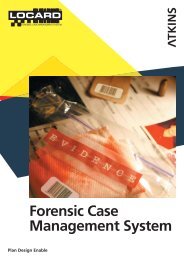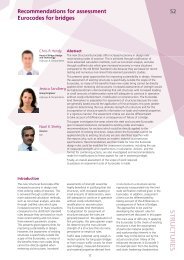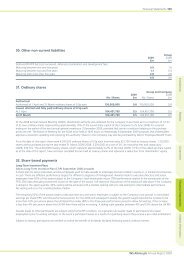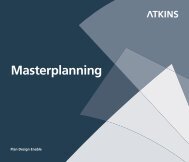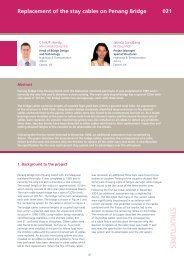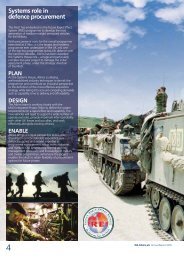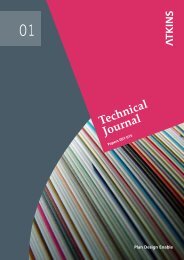View - Atkins
View - Atkins
View - Atkins
Create successful ePaper yourself
Turn your PDF publications into a flip-book with our unique Google optimized e-Paper software.
Financial Statements 75<br />
(c) Interpretations to existing standards that are not yet effective and have not been early adopted by the Group<br />
The following interpretations to existing standards have been published that are mandatory for later accounting periods and the Group<br />
has not early adopted:<br />
• IFRIC 14, IAS 19, The limit on a defined benefit asset, minimum funding requirements and their interaction (effective for accounting<br />
periods beginning on or after 1 January 2008). IFRIC 14 provides guidance on assessing the limit in IAS 19 on the amount of the<br />
surplus that can be recognised as an asset. It also explains how the pension asset or liability may be affected by a statutory or<br />
contractual minimum funding requirement. The Group will apply IFRIC 14 from 1 April 2008, but it is not expected to have any<br />
impact on the Group’s or Company’s accounts based on current IAS 19 assumptions.<br />
(d) Interpretations to existing standards that are not yet effective and not relevant for the Group’s operations<br />
The following interpretations to existing standards have been published that are mandatory for later accounting periods but are<br />
not relevant for the Group’s operations:<br />
• IFRIC 13, Customer loyalty programmes (effective for annual periods beginning on or after 1 July 2008). IFRIC 13 clarifies that where<br />
goods or services are sold together with a customer loyalty incentive (for example, loyalty points or free products), the arrangement<br />
is a multiple-element arrangement and the consideration receivable from the customer is allocated between the components of the<br />
arrangement using fair values. IFRIC 13 is not relevant to the Group or Company’s operations because none of the Group’s companies<br />
operate any loyalty programmes.<br />
(e) Interpretations to existing standards that are not yet effective and the principles have been applied by the Group<br />
The following interpretations to existing standards have been published that are mandatory for later accounting periods and the<br />
Group has applied the principles early:<br />
• IFRIC 12, Service Concession Arrangements which outlines an approach to account for contractual arrangements arising from<br />
entities providing public services.<br />
2. Financial risk management<br />
Risk factors<br />
The Group’s activities expose it to a variety of financial risks: market risk (including foreign exchange risk, fair value interest rate risk,<br />
cash flow interest rate risk and price risk), credit risk and liquidity risk. The Group’s overall risk management programme focuses on the<br />
unpredictability of financial markets and seeks to minimise potential adverse effects on the Group’s financial performance. The Group<br />
uses derivative financial instruments to hedge certain risk exposures.<br />
Risk management is carried out by a central treasury department (Group Treasury) under policies approved by the Board of Directors.<br />
Group Treasury identifies, evaluates and hedges financial risks in close co-operation with the Group’s operating units. The Board provides<br />
written principles for overall risk management, as well as written policies covering specific areas, such as foreign exchange risk, interest<br />
rate risk, credit risk, use of derivative financial instruments and non-derivative financial instruments, and investment of excess liquidity.<br />
These policies are further described within the Treasury Policies and Objectives section of the Operating and Financial Review.<br />
Where individual sensitivities are disclosed below, all other variables are held constant.<br />
a) Market risk<br />
i) Foreign exchange risk<br />
The Group operates in a number of international territories. Each business undertakes a large proportion of its commercial transactions<br />
within its local market and in its local functional currency. Foreign exchange risk arises from the small proportion of commercial<br />
transactions undertaken in currencies other than the local functional currency, from financial assets and liabilities denominated in<br />
currencies other than the local functional currency and on the Group’s net investments in foreign operations.<br />
Group policy is for each business to undertake commercial transactions in its own functional currency whenever possible. When this<br />
is not possible, the Group manages its foreign exchange risk from future commercial transactions using appropriate derivative contracts<br />
arranged via Group Treasury. Cash flows are reviewed on a monthly basis throughout the duration of future projects and the future<br />
cover amended as appropriate.<br />
Trade receivables and payables denominated in currencies other than the local functional currency arise from commercial transactions<br />
and are therefore largely hedged as part of the process described above. Remaining financial assets and liabilities denominated in<br />
currencies other than the local functional currency include bank accounts, loans and intercompany funding balances. These are<br />
unhedged with the exception of balances that are themselves designated as hedging instruments used to hedge the Group’s net<br />
investment in foreign operations.<br />
Introduction Reviews Governance Financial Statements Investor Information<br />
WS <strong>Atkins</strong> plc Annual Report 2008



